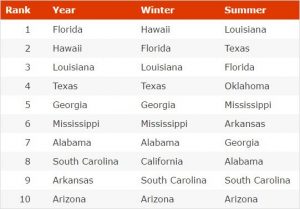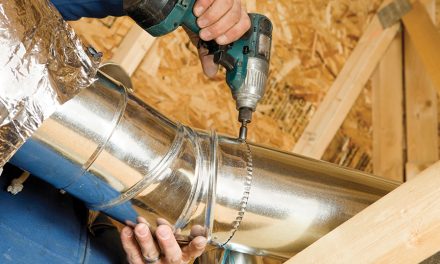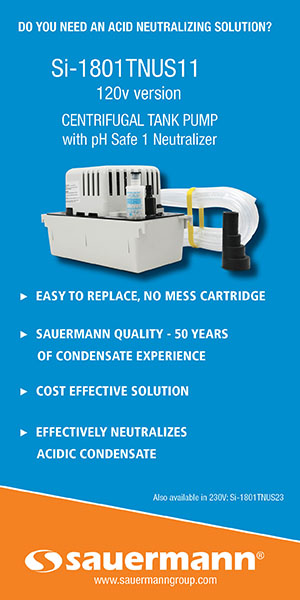
David Holt is Director, Business Training and Coaching for National Comfort Institute
On June 21st, we officially transition from spring to summer in the northern hemisphere.
According to National Oceanic and Atmospheric Administration (NOAA) weather statistics, the hottest states in the U.S. are concentrated in the south-central region and southeastern corner of the country. During every season, Florida, Louisiana, and Texas are consistently among the top four of the nation’s hottest states, based on state-wide average temperatures (See Figure 1)
Several other states round out the southeast’s lead in annual and seasonal temperatures. The fifth and sixth hottest states throughout the year are Georgia and Mississippi, which have similar average temperatures. Alabama, South Carolina, and Arkansas come in close behind.

Figure 1: According to U.S. national weather service (NOAA), these are the top 10 ‘hottest’ states in the U.S.
State-wide averages of temperatures provide a general indication of climate, but the broad averages can mask significant temperature variations within a state. For smaller states like Rhode Island, the differences may not be substantial. But for bigger states like California, with topography that ranges from ocean beaches to snowy mountain peaks, temperatures vary wildly. The Golden State isn’t even among the top ten hottest in the summer, yet it’s home to Death Valley, where summer temperatures regularly hit triple digits, well above all others in North America.
Extreme Heat Fires Up Service & Replacement Opportunities
Without a doubt, the HVAC service and replacement business really heats up during blistering summer months. During a summer heat wave, most HVAC service and replacement businesses will encounter the following situations:
- Aging HVAC equipment breaking down more often when it runs non-stop for extended periods of time.
- Customers reporting significant variations in room-to-room comfort levels when outside temperatures and humidity are well above typical design conditions.
- Consumers complaining of high monthly utility bills become commonplace.
- Consumers noticing excessive dust and ‘apparent biological growth.’
That sounds like a whole bunch of good sales leads, right? You bet it is! However, when you wait for extreme weather to drive your business, those opportunities come at a significant cost. These real costs are the ingredients that can turn your hot weather bonanza into a curse.
How Hot Weather Can Curse Your HVAC Business
Think about summer through the eyes of your customers for a moment. They’ve probably set aside a little money to take the family to the beach or the mountains for a memorable vacation. They’re also looking forward to spending a little extended family time with their kids while school is out. They may even have a few ‘honey do’ projects they plan to complete in the next few weeks. They can’t wait until their friends and family come over to the house for a 4th of July cookout by the swimming pool.

Hot weather can be a curse to your business if you don’t handle it correctly. Sure, it will make you crazy busy, but will it hurt you in the near future?
One thing they’re surely not thinking about is repairing or replacing their HVAC system!
When your customer’s air conditioning system fails during sizzling summer months, they face many difficult situations including:
- Taking time off from work to wait for a service technician that may or may not arrive as promised.
- Waiting longer than they’d like in their uncomfortable (and sometimes uninhabitable) home because there aren’t enough service technicians available to catch all the ‘no cooling’ calls.
- Not feeling loyal to their ‘preferred’ contractor when the unexpected expense is higher than they can afford or the work schedule is backed up for weeks.
- Shopping your competitors in search of the ‘lowest bid’ due to the significant financial expenditure they face.
- Receiving less-than-professional workmanship because many contractors take lots of repair and installation ‘short cuts’ just to keep up with demand.
- Dealing with exhausted installation crews who are working non-stop and not doing their best work possible.
Does this sound like a formula for happy customers who pay a premium price for a premium product? Do you see these customers helping to grow your business through glowing testimonials, reviews, and referrals? I think not! This type of business typically results in unhappy customers, unhappy employees, and unprofitable business.
Don’t Let the Heat Challenge Your Integrity
When hot weather hits, most contractors go into ’emergency mode,’ forgoing many important quality- and business-improving procedures in favor of expediency. They focus on picking ‘low-hanging fruit’ without regard to the many opportunities for making everyone’s life better. To catch as many calls as possible, they take shortcuts.
In other words, they guess, they don’t measure. As a result, they provide greatly diminished quality. They promise much but deliver little. Don’t let the flood of opportunities brought on by hot weather cause you to set aside your integrity. There are better ways to handle things. Consider this real-world example:
A Medical Analogy
Let’s say a huge flu epidemic breaks out in your community. You catch the flu so you call the doctor’s office. Not surprisingly, doctor is swamped. The receptionist says they’ll squeeze you in so you head there right away. You check in at the front desk. They ask for your insurance card and co-pay. ‘You sit down. The waiting room is packed with sick folks. You feel terrible and so do they. You wait’ and you wait’ and you wait some more.
The office staff is running people through at a pace you’ve never seen before. They’re calling names every minute or two and the waiting room begins to clear out. You’re feeling pretty good that they might be able to see you at the current pace. Suddenly, the front door opens and a long line of new patients stream in, filling up all the available seats in the waiting room once again.
After what seems like days, the nurse opens the door and finally calls your name. You get up, slowly head to the door, and turn towards the ‘vital signs’ station. You’ve been here many times before so you know the routine. She turns and abruptly says ‘we don’t have time for any of that today ‘ we are way too busy. Come with me.’ As you turn to follow her, you frown because they’ve never done it that way before.
She hustles you to an exam room and tells you to sit down to wait for the doctor. She closes the door quickly behind her, leaving you alone and confused. ‘That was weird’, you think to yourself. ‘They’ve never taken me back to the exam room without first measuring and recording my weight, temperature, pulse, and blood pressure. How do they know what’s going on without taking those measurements??
When the doctor finally comes in, he hands you a prescription for Tamiflu, tells you to call him back if this doesn’t fix it in the next two days, and heads back out the door as quickly as he came in.
As a patient, how do you feel about this treatment? Probably a little less than satisfied, right?
Sadly, many contractors resort to this level of service when outdoor temperatures heat up. Rather than following the proper diagnostic procedures to determine exactly what’s going on with their customer’s system, they prescribe a band-aid fix and quickly move on to the next patient. Your customers will surely be a little less than satisfied with this level of service, much the same way you were as a flu patient.
Emergency Rooms Lead to Surgery and Rehabilitation

Life in the ER can go from calm and boring to overwhelmingly chaotic in a matter of minutes. Just like life in an HVAC contracting firm during a Summer heat wave.
Taking the medical analogy further, consider the typical major hospital. Most feature an Emergency Room (ER) dedicated to handling acute care of patients who show up without an appointment. Because patients can show up at any time and with any complaint, a key ER responsibility is’ prioritizing cases based on medical need. This process is called triage.
Due to the unplanned nature of their cases, the ER must be able to provide initial treatment for a broad range of illnesses and injuries. Some cases may be life-threatening and require immediate attention while others may lead to further specialized treatment handled in other departments throughout the hospital. Life in the ER can go from calm and boring to overwhelmingly chaotic in a matter of minutes.
While some life-saving emergency surgery may be performed immediately, the primary goal of the ER Doctor is to quickly stabilize the patient and transfer them to other departments that specialize in treating the specific condition from which the patient suffers. Once admitted to the ‘specialty unit? (like cardiology, critical care, gastroenterology, neurology, etc.), the treatment team can develop and schedule a customized care plan. This side of the hospital operates in a more controlled manner and is typically much less chaotic.
Triage Entry Point
The ER is an important hospital ‘entry point’ for patients requiring more extensive treatment, just like your Service Department is an important entry point for your maintenance, equipment replacement, and system renovation business. Your ER Doctors (Service Techs) must efficiently diagnose the customer’s problems, ‘stabilize’ the customer by immediately resolving urgent issues, and then — depending on the severity or the issue — refer them to the appropriate ‘specialty unit? (Maintenance, Comfort Advisors, Installers) for further treatment.
For the HVAC industry, hot weather is like a mass casualty event for the ER. When it gets hot and mechanical equipment starts failing, our technicians are called into action to stabilize as many customers as they can. They are wizards at quickly getting systems back up and running. Your customers really appreciate that. What would we do without our well-trained and well-equipped service techs?
But do they regularly look for opportunities to transfer the patient to one of your specialty units for further treatment? Do they record the proper ‘vital sign’ measurements that point out future ‘non-emergency’ services that can be performed in the milder weather months right around corner? Are they just putting band-aids on major opportunities to improve customer safety, health, comfort, and system efficiency?
Don’t Let Summer Heat Cook Your Brain
When most contractors get busy, they forget about the mild-weather doldrums that occurs in just a few short months.
Don’t let the heat of summer cook your brain and keep you from planning for the fall. If your service team doesn’t keep their eyes, ears, and test instruments focused on identifying future opportunities while taking care of the emergencies, you’ll wake up this fall waiting again for the phone to ring. By doing that, you just flush most of the profits you earned this summer right down the drain.
Don’t let hot weather be a curse for your business. Use this time to capture information about opportunities to better serve your customers in upcoming months. Your customer, your employees, and your checkbook will be glad you did.













Trackbacks/Pingbacks